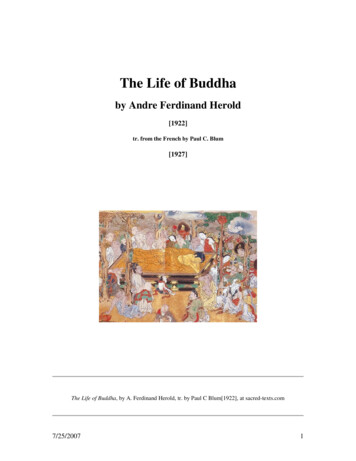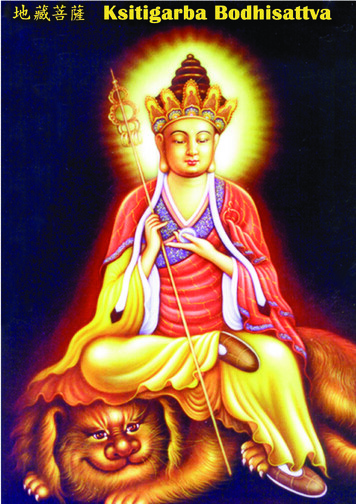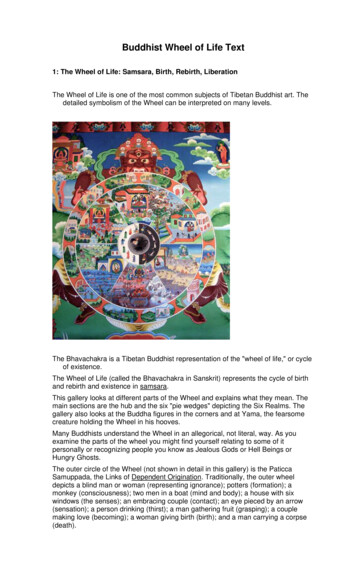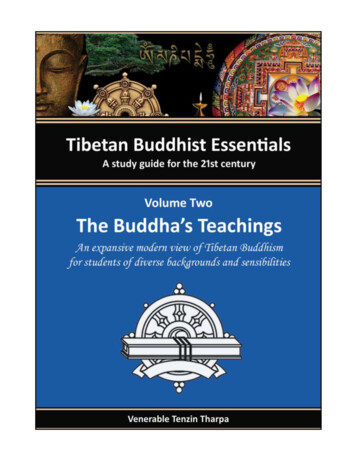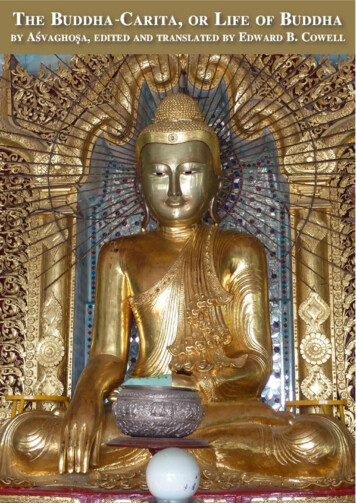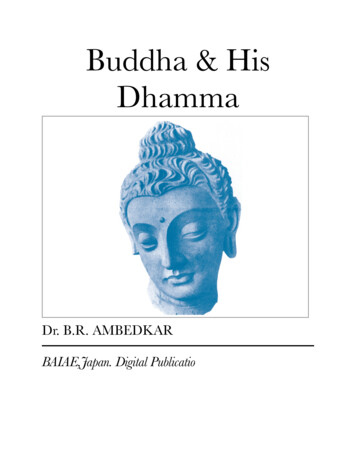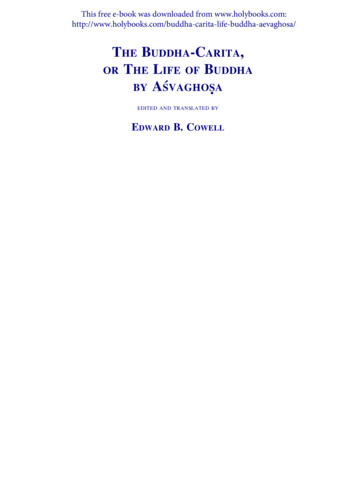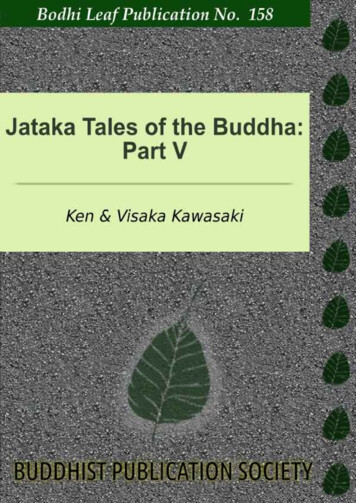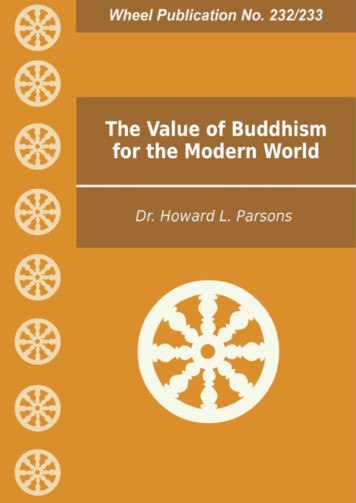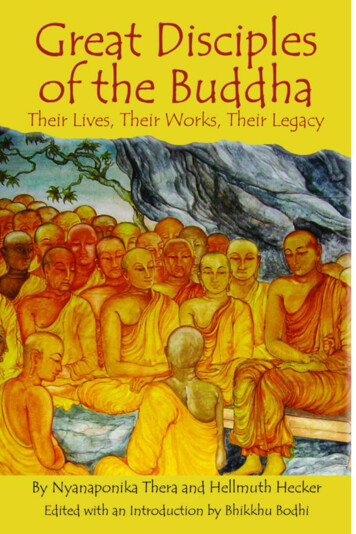
Transcription
GREAT DISCIPLESOF THEBUDDHA
GREAT DISCIPLESOF THEBUDDHATheir Lives, Their Works, Their LegacyNYANAPONIKA THERAANDHELMUTH HECKEREdited with an Introduction byBHIKKHU BODHIBU DD H IST P UBLI CAT ION SOC IET YKANDY SRI LANKA
Buddhist Publication SocietyP.O. Box. 6154, Sangharaja MawathaKandy, Sri LankaCopyright 1997, 2007 by Buddhist Publication SocietyAll rights reservedFirst published : 1997 by Wisdom PublicationsReprinted : 2004 by Wisdom PublicationsAsia Edition : 2007, 2018 by Buddhist Publication SocietyNatioal Library of Sri Lanka - Cataloguing in Publication DataNyanaponika HimiGreat Disciples of the Buddha: Their lives, their works, their legacy/Nyanaponika Himi; Helmuth Hecker.- Kandy: BuddhistPublicaion Society Inc., 2007. - p.418; 22cm. (BP 417)ISBN : 978-955-24-0301-9Price :i. 294.363 DDC 22iii. Hecker, Helmuth–jt.au.ii. Title1. Buddha2. BuddhismISBN 13 : 978-955-24-0301-9Printed byChampika Printers,343, Colombo Rd, Kurunegala.
CONTENTSPrefaceCreditsAbbreviationsEditor’s IntroductionThe place of discipleship in BuddhismTwo Types of DisciplesThe Great DisciplesThe Present BookSourcesA Note on MethodixxixiixiiixiiixvxixxxivxxviixxxSĀRIPUTTA: THE MARSHAL OF THE DHAMMAPrologueThe Quest for the DhammaThe Original AspirationSāriputta in the JātakasSāriputta the ManThe HelperThe UnresentfulFriendships and RelativesThe MeditatorThe Turner of the WheelThe SuttasExpository WorksThe AbhidhammaThe Further ShoreCunda SuttaUkkacelā SuttaDiscourses of SāriputtaThe Majjhima NikāyaDīgha NikāyaAṅguttara NikāyaSaṃyutta �MOGGALLĀNA: MASTER OF PSYCHIC POWERSYouthWandering and Spiritual SearchFinding the Dhamma676974v
Great Disciples of the BuddhaThe Struggle for Realization of the TeachingThe Most Excellent Pair of DisciplesMoggallāna’s Psychic PowersPenetration of Others’ Minds (Thought Reading)The Divine Ear (Clairaudience)The Divine Eye (Clairvoyance)Travel by Mind-Made Body (Astral Travel)Telekinesis (Supernormal Locomotion)The Power of TransformationMoggallāna’s Previous LivesMoggallāna’s VersesThe Last Days of MoggallānaMoggallāna’s Death768287909192939495969799100MAHĀKASSAPA: FATHER OF THE SANGHAKassapa’s Early YearsBhaddā KapilānīThe Saṃsāric BackgroundHow Kassapa Came to the BuddhaKassapa’s Relationship to the BuddhaEncounters with DeitiesRelations with Fellow MonksAfter the Buddha’s ParinibbānaThe Verses of Mahākassapa105109110113116120121126129ĀNANDA: GUARDIAN OF THE DHAMMAĀnanda’s Personal PathĀnanda’s RenownThe Buddha’s AttendantThe Guardian of the DhammaĀnanda’s Attitude Toward WomenĀnanda and his Fellow MonksConversations with the BuddhaĀnanda’s Former LivesJātaka 498Jātaka 421Jātaka 282The Last Days of the BuddhaAfter the Buddha’s 4vi
ContentsANURUDDHA: MASTER OF THE DIVINE EYEEarly Life and OrdinationThe Struggle for ArahantshipAnuruddha’s Spiritual PathLife in the SanghaAnuruddha and WomenAnuruddha’s Earlier LivesThe Buddha’s Parinibbāna and Afterward179182185188193198202MAHĀKACCĀNA: MASTER OF DOCTRINAL EXPOSITIONIntroductionThe Saṃsāric BackgroundKaccāna’s Conversion to the DhammaVarious IncidentsThe Elaborator of Brief StatementsThe Majjhima NikāyaThe Saṃyutta NikāyaThe Aṅguttara NikāyaOther Teachings of MahākaccānaThe Theragāthā VersesThe Exegetical Treatises205206208211215216222225227233235GREAT WOMEN DISCIPLES OF THE BUDDHAVisākhā:The Buddha’s Chief PatronessMallikā: The Flower-Girl QueenKhemā: Of Great WisdomBhaddā Kuṇḍalakesā: The Debating AsceticKisāgotamī: The Mother with the Dead ChildSoṇā With Many ChildrenNandā: The Buddha’s Half-SisterQueen Sāmāvatī: Embodiment of Loving-KindnessPaṭācārā: Preserver of the VinayaAmbapālī: The Generous CourtesanSirimā and UttarāIsidāsī: A Journey Through GULIMĀLA: A MURDERER’S ROAD TO SAINTHOODThe Making of a Serial KillerAṅgulimāla Becomes a Monk311314vii
Great Disciples of the Buddha“Born with the noble birth”Aṅgulimāla’s Verses319322ANĀTHAPIṆḌIKA: THE BUDDHA’S CHIEF PATRONAnāthapiṇḍika Becomes a DiscipleThe Wealthy PatronAnāthapiṇḍika’s FamilyAnāthapiṇḍika and his FriendsDiscourses by the Blessed OneThe Death of Anāthapiṇḍika325329333336338348SHORTER LIVES OF THE DISCIPLESThe Householder CittaThe Bhikkhu CittaFather and Mother NakulaNotesBibliographyPāli English TranslationsReference WorksContributorsviii351359361366367381381382383
PREFACEWhile in recent years in the West oceans of ink have been expended onbooks dealing with the Buddha and his Teaching, the first two Jewelsof Buddhism, the coverage given to the third Jewel, the Sangha, hasbeen far from adequate. Even the meaning of the word “sangha” hasbeen a matter of dispute, while for those without access to the originalPāli texts a dense cloud of obscurity still hangs over the Buddha’s original nucleus of disciples. This gap is all the more glaring because thevery measure of the Buddha’s success as a spiritual teacher is to bedetermined by his skill in training his disciples. The canonical verse ofhomage to the Buddha hails him as “the unsurpassed trainer of personsto be tamed,” and thus the acid test for the validity of this claim mustbe the mettle of the men and women who submitted to his guidance.Just as the sun is valued not only for its own intrinsic radiance but alsofor its ability to illuminate the world, so the brilliance of the Buddha asa spiritual master is determined not only by the clarity of his Teachingbut by his ability to illuminate those who came to him for refuge andto make them luminaries in their own right. Without a community ofdisciples to testify to its transformative power, the Teaching, theDhamma, would be merely a package of doctrines and formal practices, admirably lucid and intellectually rigorous, but remote from vitalhuman concerns. The Dhamma comes to life only to the extent that ittouches life, ennobling its followers and turning them into models ofwisdom, compassion, and purity.The present book is an attempt to fill this gap in Western Buddhistliterature with living portraits of twenty-four of the most distinguisheddisciples of the Buddha. The book evolved from a series of individualtracts on the great disciples issued by the Buddhist Publication Society(BPS) under its well-known imprint, The Wheel. The first biographyto appear was The Life of Sāriputta by the Venerable NyanaponikaThera. This was first published in 1966 as an independent monograph,with no intention to initiate an ongoing series. In the same year, however, the German Buddhist author Hellmuth Hecker began publishingshort biographical profiles of the great disciples in the German Buddhist periodical Wissen und Wandel (established in 1955 by PaulDebes). Over the next twenty years Wissen und Wandel carried fortyone such portraits, many quite short.ix
Great Disciples of the BuddhaIn the late 1970s the idea occurred to Ven. Nyanaponika, then theeditor of the BPS, to follow up his study of Sāriputta with a line ofWheel titles on the other great disciples, using the articles by Dr.Hecker as a basis. Thus between 1979 and 1989 there appeared, as individual Wheel booklets, portraits of Mahāmoggallāna, Ānanda, Aṅgulimāla, Anāthapiṇḍika, Mahā-kassapa, Anuruddha, and eightprominent women disciples. These had been translated into Englisheither by Ven. Nyanaponika himself or by others at his request.Finally, in 1995 I wrote a booklet on the Elder Mahākaccāna, whichwas the last to appear in the series.Almost all the original articles by Dr. Hecker were considerablyenlarged by Ven. Nyanaponika with additional material gathered fromthe Pāli Canon and its commentaries, and deepened with his owninsightful reflections. In preparing this comprehensive volume fromthe original booklets I have made substantial alterations in almost allthe older versions and added still more material to give a fuller pictureof the disciple under scrutiny. The chapter on the women disciples hasbeen expanded by the addition of four profiles that were not in theoriginal Wheel, although a full-length treatment of individual womencomparable to the studies of the leading male disciples was not possibleowing to the sparsity of source material. A thorough stylistic revisionof the original portraits was also necessary.I have retranslated almost all the verses, which in the Wheel booklets were often quoted from older translations composed in a style thatwould strike present-day readers as stilted. To leaven the proseaccounts I have added still more verses, particularly from the Theragāthā and Therīgāthā. Unless indicated otherwise all verse translationsare my own, though my verse renderings from the two collections justnamed lean heavily upon the literal prose translations by K.R. Norman, published as Elders’ Verses, parts 1 and 2.I would like to thank my long-time assistant at the BPS, AyyāNyanasirī, who first reviewed the original Wheels with the idea of reissuing them in a single volume. I also thank Mrs. Savithri Chandraratne, who diligently and accurately typed the manuscripts into thecomputer. I am grateful to Wisdom Publications for its collaborationin the publication of this book, particularly to Sara McClintock,whose editorial comments led to major improvements.Bhikkhu Bodhix
CREDITS“Sāriputta: The Marshal of the Dhamma,” by Nyanaponika Thera.First published as The Life of Sāriputta, BPS Wheel No. 90/92 (1966).“Mahākaccāna: Master of Doctrinal Exposition,” by BhikkhuBodhi. First published as BPS Wheel No. 405/406 (1995).The following biographies are all by Hellmuth Hecker, translatedinto English from the German:“Mahāmoggallāna: Master of Psychic Powers.” Trans. by Nyanaponika Thera. First published as Mahā-Moggallāna, BPS Wheel No.263/264 (1979).“Mahākassapa: Father of the Sangha.” Revised and enlarged trans.by Nyanaponika Thera. First published as BPS Wheel No. 345 (1987).“Ānanda: Guardian of the Dhamma.” Trans. by Sister Khemā.First published as BPS Wheel No. 273/274 (1980).“Anuruddha: Master of the Divine Eye.” Revised and enlargedtrans. by Nyanaponika Thera. First published as BPS Wheel No. 362(1989).“Great Women Disciples of the Buddha.” Trans. by Sister Khemā.First published as Buddhist Women at the Time of the Buddha, BPS WheelNo. 292/293 (1982). The following stories are new to this volume:“Visākhā: The Buddha’s Chief Patroness” (trans. by Friedgard Lottermoser, enlarged by Bhikkhu Bodhi); “Ambapāli: The Generous Courtesan,” “Sirimā and Uttarā,” and “Isidāsī: A Journey through Saṃsāra”(trans. by Amadeo Solé-Leris).“Aṅgulimāla: A Murderer’s Road to Sainthood.” Enlarged trans.by Nyanaponika Thera. First published as BPS Wheel No. 312 (1984).“Anāthapiṇḍika: The Buddha’s Chief Patron.” Trans. under supervision of Nyanaponika Thera. First published as Anāthapiṇḍika: TheGreat Benefactor, BPS Wheel No. 334 (1986).“Shorter Lives of the Disciples.” Adapted from a translation byMudita Ebert. First published as BPS Wheel No. 115 (1967).Translations from the Pāli sources are by the respective authors, unlessotherwise noted. Verse translations are by Bhikkhu Bodhi, unless otherwise noted.xi
ABBREVIATIONSANApAṅguttara Nikāya (by section and sutta)Apadāna (I Thera-apadāna, II Therī-apadāna;by chapter and section; Burmese-script ed.)BLBuddhist Legends (Dhp Comy.)BPSBuddhist Publication Society (Kandy, Sri Lanka)Comy. CommentaryDhpDhammapada (by verse)DNDīgha Nikāya (by sutta number)JJātaka (by number)MilMilindapañhāMNMajjhima Nikāya (by sutta number)PTSPali Text Society (Oxford, England)PvPetavatthuSNSaṃyutta Nikāya (by chapter and sutta)SnSuttanipāta (by verse, or sutta)ThTheragāthā (by verse)ThīTherīgāthā (by verse)UdUdāna (by chapter and sutta)VinVinaya (by volume and page)Vism Visuddhimagga (chapter and paragraph ofThe Path of Purification)VvVimānavatthu (by verse)All references are to PTS editions unless otherwise noted.xii
Editor’s IntroductionTHE PLACE OF DISCIPLESHIP IN BUDDHISMAs a religious founder the Buddha did not claim to be a divinely inspiredprophet, a personal saviour, or a deity incarnate in flesh. Within theframework of his Teaching, the Dhamma, his special role is that of ateacher, the Supreme Teacher who reveals the unique path to finaldeliverance. In the earliest form of the Teaching, as represented by thePāli Canon, no essential difference divides the goal attained by theBuddha himself from that realized by his disciples. For both the goal isthe same, Nibbāna, the perfect liberation of the mind from allconstricting bonds and the consequent release from saṃsāra, the roundof repeated birth and death.The differences between the Buddha and his disciples concern,first, the temporal sequence of their attainment and, second, thepersonal qualities which they acquire through their realization of thegoal. In terms of temporal sequence, the Buddha is the discoverer ofthe path to Nibbāna, while his disciples are those who tread the pathunder his guidance and thereby gain the fruit: “The Tathāgata, monks,is the originator of the path unarisen before, the producer of the pathunproduced before, the declarer of the path undeclared before. He isthe knower of the path, the finder of the path, the one skilled in thepath. And his disciples now dwell following that path and becomepossessed of it afterwards. This, monks, is the distinction, thedisparity, the difference between the Tathāgata, the Arahant, the FullyEnlightened One, and a monk liberated by wisdom” (SN 22:58).In terms of personal qualities, the Buddha, as the founder of theSāsana, the Teaching or “Dispensation,” possesses a vast array of skillsand modes of knowledge that are not fully shared by his disciples.These cognitive faculties include not only certain thaumaturgicalpowers but also the unimpeded knowledge of the constitution of theworld with its many planes of existence and a thorough understandingof the diverse mental proclivities of sentient beings.1 Such faculties arenecessary to enable the Buddha to fulfil his essential mission ofestablishing the Dispensation in the world at large and of guidingcountless beings to liberation from suffering.Since the Buddha’s aim when he first “set in motion the Wheel ofthe Dhamma” was to lead sentient beings to Nibbāna, the very structureof his Teaching presupposes a relationship of discipleship between
xivGreat Disciples of the Buddhahimself and those who hearken to his message. The Buddha is the fullyenlightened teacher (satthā); his Teaching (sāsana) is an injunction toundergo a particular course of training; and those who conform to thedemands of discipleship do so by following his injunction (sāsanakara)and complying with his advice (ovādapaṭikara). Even at the close of hisministry, as he lay on his deathbed between the twin sāla trees atKusinārā, he declared that it was not by external acts of homage that theTathāgata, the Perfect One, was properly worshiped, but by theconsistent and dedicated practice of the Dhamma (DN 16).The course of discipleship under the Buddha begins with an act offaith (saddhā). Faith, for Buddhism, is not an unquestioning assent topropositions beyond the range of possible verification but a readiness toaccept on trust the claim that the Buddha makes about himself: that he isthe Fully Enlightened One, who has awakened to the deepest, mostcrucial truths about the nature of sentient existence and who can showthe path to the supreme goal. The placing of faith in the Buddha’sEnlightenment is manifested by the process of “going for refuge” to theThree Jewels of Buddhism (tiratana): to the Buddha as one’s mentor andspiritual guide; to his Teaching, the Dhamma, as the most perfectexpression of existential truth and the flawless path to liberation; and tothe Ariya Sangha, the community of noble ones, as the corporateembodiment of wisdom and spiritual purity. Faith necessarily leads toaction, to the undertaking of the training, which in concrete termsmeans the implementation in one’s life of the guidelines the Buddha haslaid down for his followers. These guidelines vary widely independence on the situation and aptitude of the disciple. Certain sets ofguidelines are more appropriate for lay followers, others moreappropriate for monastics, and it is the disciple’s task to make the rightchoice among them. But all such guidelines, originating from differentstarting points, eventually converge upon a single path, universal andunique, leading infallibly to the final goal. This is the Noble EightfoldPath, the way to the cessation of suffering, with its three divisions ofvirtue (sīla: right speech, right action, right livelihood), concentration(samādhi: right effort, right mindfulness, right concentration), andwisdom (paññā: right view, right intention).Those who accept the Buddha as teacher and attempt to follow hispath are his sāvaka (Skt. śrāvaka), his disciples. The category ofdiscipleship cuts across the conventional distinction between themonastic order and the lay community and thus embraces thetraditional “four assemblies” of Buddhist followers: bhikkhus andbhikkhunīs (monks and nuns) and upāsakas and upāsikās (laymen and
Two Types of Disciplesxvlaywomen). Although later texts of the Mahāyāna tradition speak ofthe sāvakas as if they formed a distinct class of disciples—a classcontrasted unfavourably with the bodhisattvas—the early Buddhistscriptures do not know any such distinction but use the word sāvakabroadly to refer to all those who accept the Buddha as their master.The word is derived from the causative verb sāveti, “to inform, todeclare,” and thus means those who declare the Buddha to be theirmaster (or perhaps those to whom the Dhamma has been declared). Inthe early texts sāvaka is used not only as a designation for the Buddha’sdisciples but also for the followers of other spiritual systems in relationto their own mentors.TWO TYPES OF DISCIPLESWithin the wide circle of the Buddha’s followers a critical distinction isdrawn between two types of disciples, the ordinary disciples and thenoble disciples. The differences that divide them do not pertain tooutward form and mode of life but to inward spiritual stature. Suchdifferences will become clearer if we discuss them in the light of theworldview that underlies both the Buddhist tradition as a whole and thebiographical profiles that constitute the substance of the present volume.The compilers of the Buddhist scriptures accept as axiomatic aworldview that differs significantly from the picture of the universebequeathed to us by modern science. This worldview is characterizedby three basic and interrelated premises. The first is that the sentientuniverse is a multitiered edifice, with three primary realms divided intoa number of subsidiary planes. The grossest tier is the sense-desire realm(kāmadhātu), which consists of eleven planes: the hells, the animalkingdom, the sphere of ghosts, the human realm, the sphere of titans,and the six sensuous heavens; of these, only the human realm and theanimal kingdom are normally accessible to our natural sense faculties.Above the sense-desire realm is the fine-material realm, or the realm ofsubtle form (rūpadhātu), an ascending series of some sixteen exaltedplanes which are the ontological counterparts of the jhānas, themeditative absorptions; here the grosser aspects of matter have fadedaway and the beings enjoy far greater bliss, peace, and power than isordinarily accessible in the terrestrial realm. Finally, at the pinnacle ofthe Buddhist cosmos is the immaterial realm (arūpadhātu), four planesof extremely attenuated nature corresponding to the four immaterialmeditative absorptions (arūpajjhāna): here matter has disappearedcompletely and the denizens are of a purely mental constitution.2
xviGreat Disciples of the BuddhaThe second axiom concerns rebirth. Buddhism holds that allunenlightened beings, those who have not eradicated ignorance andcraving, are bound to be reborn within the three realms. The course oftransmigration is without discoverable beginning. It is propelled fromwithin by ignorance and craving, which drive the stream ofconsciousness from death to new birth in a repeatedly self-sustainingprocess. This uninterrupted succession of births and deaths is calledsaṃsāra, “the wandering on,” the round of repeated existence.The third axiom is the principle that determines the sphere ofrebirth. This is what the Buddha calls kamma, action, specificallyvolitional action. According to the Buddha, all our morallydeterminate volitional actions are subject to an inescapable law ofretribution. Our deeds leave behind, in the ongoing stream ofconsciousness, a potential to produce results (vipāka), to bring forthfruits (phala), which appear when the accumulated kamma meets withexternal conditions congenial to its germination. Kamma determinesnot only the specific plane into which one is reborn but also ourinherent capacities and propensities and the basic direction of our lives.The mode by which kamma operates is an ethical one: unwholesomekamma—deeds motivated by greed, aversion, and delusion—brings abad rebirth and engenders pain and suffering; wholesome kamma—deeds inspired by generosity, kindness, and wisdom—leads to a goodrebirth and to happiness and well-being.3Since all experience within the round of rebirth is impermanentand unsatisfactory, the ultimate aim for early Buddhism is to break freefrom this self-generating cycle and thereby win the unconditionedstate, Nibbāna, where there is no more birth, aging, and death. This isthe goal the Buddha himself attained as the culmination of his ownnoble quest, and it is also the goal he constantly set before his disciples.The distinction between the two types of disciples pertains to theirrelationship to this goal. The class of ordinary disciples, which is by farthe more numerous of the two, consists of those who are stilltechnically classed as worldlings or commoners (puthujjana). Suchdisciples may have sincerely gone for refuge to the Three Jewels andmay be fully devoted to the practice of the Dhamma, but despite theirearnestness they have not yet reached the plane where liberation isirrevocably assured. They have not yet seen the Dhamma forthemselves, nor eliminated the mental fetters, nor entered irreversiblyupon the path to final emancipation. Their present mode of practice ispreparatory in character: it is intended to bring their spiritual facultiesto maturity so that, in due course, they may enter upon the
Two Types of Disciplesxviisupramundane path. Until that experience dawns, however, they mustwander on through the round of rebirths, uncertain of their futuredestination, still liable to moral lapses and even to rebirth in the lowerrealms.In contrast to this class stands the class of noble disciples, theariyasāvaka.4 These disciples have surmounted the plane of theworldlings, have arrived at the stage of irreversibility, and are assured ofreaching the final goal in a maximum of seven more births. What hasraised them from the status of a worldling to the plane of spiritualnobility is a radical transformation that has occurred at the very base ofthe mind. This transformation may be viewed from two complementaryperspectives, one cognitive, the other psychological. The suttas refer tothe cognitive aspect as the gaining of the vision of the Dhamma(dhammacakkhu-paṭilābha) and the breakthrough to the Dhamma(dhammābhisamaya).5 Such an event, altering one’s destiny for all time,generally takes place after the disciple has fulfiled the preliminaryrequisites of the training and has been engaged in the practice of insightmeditation (vipassanā-bhāvanā). As deepening insights into the truenature of phenomena bring to maturity the faculty of wisdom (paññā),at a certain point, when all conditions are ripe, the mists of ignorancemomentarily disperse, affording the disciple an immediate glimpse of theunconditioned element, the Deathless, which is the precondition andfinal term of the whole process of liberation.When this vision dawns the disciple becomes a true heir to theBuddha’s message. The texts describe such a disciple as “one who hasseen the Dhamma, reached the Dhamma, understood the Dhamma,fathomed the Dhamma, who has overcome all doubt and perplexity,and become self-sufficient in the Master’s Teaching” (e.g., at MN 74).Even though the vision may still be clouded and imperfect, the disciplehas won access to the ultimate truth and it is only a matter of timeuntil, by diligent practice, he or she brings this vision to itsculmination in enlightenment (sambodhi), the complete experientialunderstanding of the Four Noble Truths.The other aspect of the transformation which the discipleundergoes pertains to the constitution of the psyche. It consists in thepermanent elimination of certain unwholesome mental dispositionscalled defilements (kilesa). For purposes of exposition, the defilementsare usually classified into a set of ten fetters (saṃyojana), called thusbecause they hold beings in bondage to the round of rebirths. Fromthe suttas it appears that in exceptional cases a disciple with a highdegree of wisdom from previous lives can cut off all ten fetters at a
xviiiGreat Disciples of the Buddhasingle stroke, thereby advancing in one leap from the stage of aworldling to that of an arahant, a fully liberated one. The more typicalprocess of attainment, however, is a calibrated one whereby the fettersare cut off sequentially, in discrete clusters, on four different occasionsof awakening. This results in a fourfold gradation among the nobledisciples, with each major stage subdivided in turn into two phases: aphase of the path (magga), when the disciple is practicing for theelimination of the particular cluster of fetters; and a phase of the fruit(phala), when the breakthrough is complete and the fetters have beendestroyed. This subdivision explains the classical formula of the AriyaSangha as made up of four pairs and eight types of noble persons(yadidaṃ cattāri purisayugāni aṭṭhapurisapuggalā esa bhagavatosāvakasaṅgho).The first stage of awakening is called stream-entry (sotāpatti), becauseit is with this attainment that the disciple can properly be said to haveentered “the stream of the Dhamma” (dhammasota), i.e., the NobleEightfold Path that leads irreversibly to Nibbāna. Stream-entry is wonwith the first arising of the vision of the Dhamma and is marked by theeradication of the coarsest three fetters: personality view (sakkāyadiṭṭhi),the view of a substantial self within the empirical person; doubt in theBuddha and his Teaching; and wrong grasp of rules and vows(sīlabbataparāmāsa), the belief that mere external observances (includingreligious rituals and penitential forms of asceticism) can lead to salvation.With the cutting off of these three fetters the stream-enterer is freed fromthe prospect of rebirth in the plane of misery (apāyabhūmi), the threelower realms of the hells, the animal kingdom, and the sphere of spiritsor “hungry ghosts.” Such a one is certain to attain final liberation in atmost seven more lifetimes passed either in the human world or in theheavens.The next major stage of awakening is that of the once-returner(sakadāgāmi), who will be reborn only one more time in the humanrealm or in the sense-sphere heavens and there reach the ultimate goal.The path of once-returning does not eradicate any fetters beyond thosealready eliminated by the path of stream-entry. It does, however,attenuate the three root defilements—greed, hatred, and delusion—sothat they arise only sporadically and then only in a mild degree.The third path, that of the non-returner (anāgāmi), cuts off twodeep roots of emotional turbulence within the psyche: the defilementsof sensual lust and ill will, the fourth and fifth fetters, which areremoved in all their manifold guises, even the subtlest. Because thesetwo fetters are the principal ties that keep living beings bound to the
The Great Disciplesxixsense-desire realm, the non-returner, as the name implies, never returnsto this realm. Rather, such a one is spontaneously reborn in one of theexalted form-realm heavens called the Pure Abodes (suddhāvāsa),accessible only to non-returners, and there attains final Nibbānawithout ever coming back to this world.The fourth and final stage of noble discipleship is that ofarahantship (arahatta), which is attained by the elimination of the fivesubtle fetters that remain unabandoned even in the non-returner:desire for existence in the form realm and formless realm, conceit,restlessness, and ignorance. As ignorance is the most deeply groundedof all the defilements, when the path of arahantship arises fullyfathoming the Four Noble Truths, ignorance collapses, bringing all theother residual defilements along with it. The mind then enters upon“the taintless liberation of mind, liberation by wisdom, attained by thedestruction of the taints”—the state that the Buddha calls theunsurpassed consummation of the holy life.The arahant is the fully accomplished disciple of early Buddhism,the perfect model for the entire Buddhist community. Even theBuddha himself, with respect to his liberation, is described as anarahant, and he declared the arahants to be his equals in regard to thedestruction of defilements. For the arahant there is no further task tobe achieved and no falling away from what has been achieved. He orshe has completed the development of the noble path, has fullyunderstood the true nature of existence, and has eradicated all themind’s bonds and fetters. For the duration of life the arahant abides inunruffled peace, in the experiential realization of Nibbāna, with amind stainless and secure. Then, with the break-up of the body at theend of the life span, he or she reaches the end of the entire process ofre-becoming. For the arahant death is not the passageway to a newrebirth, as it is for all others, but the doorway to the unconditionedstate itself, the Nibbāna-element without residue of conditioned
The present book is an attempt to fill this gap in Western Buddhist literature with living portraits of tw enty-four of the mos
